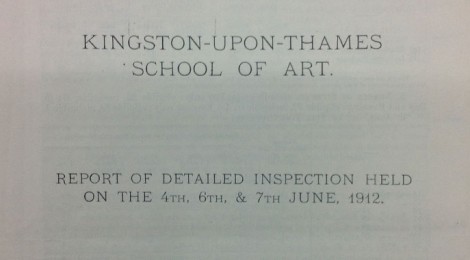
Inspection of Kingston-upon-Thames Art School, November 1936
Found in the National Archives at Kew, this report details the first inspection of the art school with Reginald Brill as Principal.
The report gives a potted history of the school, noting that “The School was established at Kingston-upon-Thames some 40 years ago. Until comparatively recent times the conditions under which it had been conducted were very unfavourable to its due and proper development. A perusal of official documents leads to the view that for a considerable part of its existence the School has been struggling against certain adverse conditions which must have been very disconcerting to those who had immediate responsibility for its success. In consequence the School did not march with the times. It is not too much to say that until recent years little or no attempt seems to have been made to bring the curriculum within the realm of practical requirements or to provide such reasonable accommodation and equipment as would have made it possible for the School to do any effective work in relation to industry.”
It is clear that the report views the appointment of Brill on January 1st 1934 as the catalyst for transforming the art school into a modern teaching institution after a period of relative stagnation, but that there was still a great deal of work needed to bring the school up-to-date. They commented, ‘The general impression left by the Inspection is that, in spite of great difficulties, good work is being done in Drawing and Painting, and to say that, is tantamount to giving high praise to the members of the teaching staff chiefly concerned.”
The inspection report is also a useful source for statistics about the school in this interwar period. It notes that 3 buildings were in use at this time: the original 1899 art school on Kingston Hall Road, a temporary hut erected 200 yards from this building, and a former elementary school in Wood Street. In 1936, there were 14 members of staff teaching at Kingston School of Art, including Reginald Brill, and they were responsible for a total of 284 students, of whom 96 were male and 188 female. The report also commented on the geographical spread of students taking full and part-time courses: “in the day time only some 37 per cent of the students attend from Kingston and Surbiton, but the corresponding percentage for evening attendance is 55.” Further, statistics were offered in the report on the ages of these students: 5 were aged under 14; 42 were between 14 and 16 years old; 84 fell into the 16-21 bracket; and 153 were aged 21 or over.
Finally, the report made a number of recommendations:
i) The urgent need of suitable and adequate premises and equipment
This was ameliorated by the move to Knights Park in late 1939 / early 1940.
ii) The importance of giving much greater attention to instruction in Industrial Design and related practical work.
iii) The possibility of so balancing the staff that the curriculum will, in turn, be better balanced. When normal staff changes are being made, it is to be hoped that this point will be borne in mind.
iv) The importance of making suitable provision for training carefully selected young persons between the ages of 13+ and 15+ in full-time Junior Department courses leading to suitable employment in artistic industry and commerce.
A Junior Department was established in 1939, consisting of two years of 25 students.
